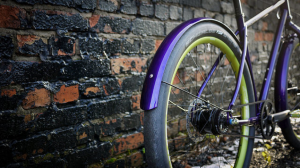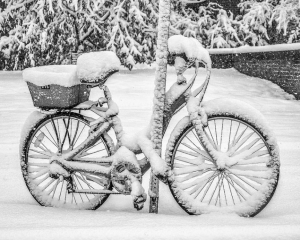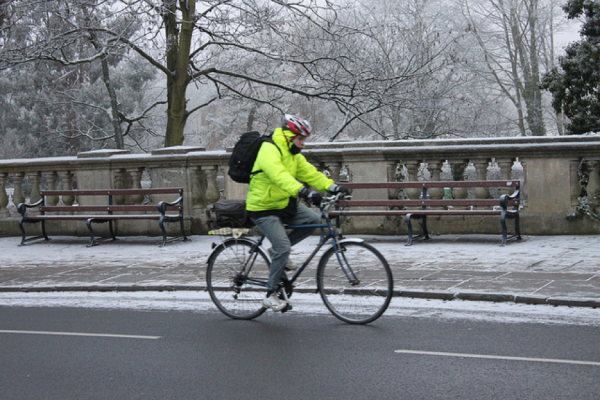This post by Jackson Smylie is part of Spacing’s partnership with the Toronto Cycling Think & Do Tank at the University of Toronto. Jackson is currently in his third year at U of T, completing his B.A. in mathematics and philosophy. An avid cyclist, he loves the challenge of downtown biking and excitedly awaits the introduction of more bike lanes. He believes that cycling has the power to effect great social, environmental, and therapeutic change. Jackson’s experience in environmental philosophy helps him understand the power of individual behavioural change within a large group.
Most cyclists say farewell to their bikes in the sub-zero Toronto winters. But although biking in cold, snowy conditions poses some problems for cyclists, they are all surmountable with adequate preparation and conscious decision making on the road! With these 5 tips, you can safely and confidently bike throughout the winter. Winter doesn’t have to stop you from saving money on transit, keeping in shape, and enjoying the outdoors!
- Stay Warm

Even though cycling is an aerobic exercise – and you may even break a sweat in the cold months – you should err on the side of warmth for your winter commutes. This means many layers of clothing and extra consideration for extremities. A sure-fire recipe for a warm ride is a pair of winter boots, double-layered clothing, mittens, a winter coat, and a balaclava.
The Bicycle Helmet Safety Institute advises against wearing a hat underneath your helmet, but your ears can stay nice and toasty with ear muffs or head bands that don’t compromise the helmet’s safety.
Most importantly, remember to account for the wind chill that comes with biking – cycling at 15km/h in still air is the same as a 15km/h wind. The colder it is, the greater the wind chill factor will be! Although wind chill will not cool your body past the actual outside temperature, it will cool your body down at a faster rate than if you are staying still. Windproof clothing is a must!
- Get the Gear

There is a seemingly endless list of supplies to buy for winter biking, but some are more essential than others. Most important is to equip your bike with extra lights, as there is typically less daylight in the winter. In addition to lights on the front and back of your bike, you could buy a clip-on light for your helmet, or even buy extra reflectors for your wheels or pedals.
Fenders are very important for a dry ride! Roads in the winter are often slushy, and fenders prevent your tires from kicking that slush up to your back and head!
Although it’s not necessary to get new tires for the winter, tubeless tires, solid tires, or carbide-studded tires help with grip and prevent flat tires. Slushy winter roads demand more from your tires than in the summer, so you could keep a durable set of tires to swap out during the cold!
3. Cycle Wisely

Every cyclist makes split-second decisions on the road, but decisions that are safe in the summer may be unwise in the colder months. You must adjust your cycling heuristics to account for black ice and slippery roads. Cycle more slowly than usual and brake well in advance of traffic lights in case you hit an icy patch. As much as it’s fun to slide down a hill on skis, sliding through a busy intersection is an adventure you should best avoid.
Cars may not expect to see cyclists in the winter, and they may not be prepared to give you lots of space on the road. To avoid collisions, you can ride a couple feet away from the curb so vehicles can see you, wear extra lights, and cycle far out from parked cars to prevent getting doored. After a snowfall, smaller roads are often not plowed, so you can plan your route ahead of time to make sure you don’t find yourself in pedal-deep snow!
Most importantly, be mentally prepared to deal with slightly worse conditions in the winter than in the summer. Take your time, focus and ride defensively.
- Know your limits

If you feel uncomfortable biking in snowy or slushy weather, you don’t have to do it! It is important to not be overcome with fear while on the road, both for your sanity and for your safety. If winter cycling has posed a big challenge for you, start with small steps, such as biking around the block to practice adapting to the new road conditions.
There are many steps you can take to make your winter ride more comfortable. Biking near bus routes ensures you have other transportation options. Try biking with friends at first to keep each other accountable; preparation leads to confidence!
- Maintenance

In addition to buying gear for the winter, it is a good idea to take extra care of your bike. Putting in a few extra minutes after your ride may save you much more time and money down the road. To prevent any deterioration, salt stains should be washed off using a sponge with warm water – using a hose may blast the grease off your bike’s chain and eventually rust its bearings.
Check your tire pressure often; higher air temperature means more air pressure. This means that colder days may require extra tire-pumping. As the days warm up again, you should let some air out of the tires to make sure the pressure does not exceed their limit. Some cyclists advise a slightly lower tire pressure in the winter to increase your grip on slippery roads.
Winter does not need to stop your pedals from turning! With adequate preparation, warm clothing, and prudent decision-making on the road, you can enjoy the frosty air all year long.

